A Many-Objective Analysis Framework for Large Real-World Water Distribution System Design Problems
Abstract
:1. Introduction
2. Proposed Methodology
2.1. Six-Objective Optimization Framework for WDSDP
2.2. System Investment Cost
2.3. Minimum Nodal Pressure
2.4. System Resilience
2.5. Background Leakage
2.6. Average Water Age
2.7. Maximum Water Age
2.8. Algorithm for Many-Objective Optimization
2.9. Water Distribution System Design Problems (WDSDP)
3. Results and Discussion
3.1. Exploring Tradeoffs in the Six-Objective Domain
3.2. Selection Strategy of Optimal Design Scheme
3.3. Further Discussion on the Solution Selection Results
4. Conclusions
Author Contributions
Funding
Institutional Review Board Statement
Informed Consent Statement
Data Availability Statement
Conflicts of Interest
References
- Huang, Y.; Duan, H.-F.; Zhao, M.; Zhang, Q.; Zhao, H.; Zhang, K. Probabilistic Analysis and Evaluation of Nodal Demand Effect on Transient Analysis in Urban Water Distribution Systems. J. Water Resour. Plan. Manag. 2017, 143, 04017041. [Google Scholar] [CrossRef]
- Fu, G.; Kapelan, Z.; Kasprzyk, J.R.; Reed, P. Optimal design of water distribution systems using many-objective visual an-alytics. J. Water Resour. Plan. Manag. 2012, 139, 624–633. [Google Scholar] [CrossRef] [Green Version]
- Zheng, F.; Zecchin, A.C.; Maier, H.R.; Simpson, A.R. Comparison of the Searching Behavior of NSGA-II, SAMODE, and Borg MOEAs Applied to Water Distribution System Design Problems. J. Water Resour. Plan. Manag. 2016, 142, 04016017. [Google Scholar] [CrossRef]
- Wang, Q.; Guidolin, M.; Savic, D.; Kapelan, Z. Two-Objective Design of Benchmark Problems of a Water Distribution System via MOEAs: Towards the Best-Known Approximation of the True Pareto Front. J. Water Resour. Plan. Manag. 2015, 141, 04014060. [Google Scholar] [CrossRef] [Green Version]
- He, G.; Zhang, T.; Zheng, F.; Zhang, Q. An efficient multi-objective optimization method for water quality sensor placement within water distribution systems considering contamination probability variations. Water Res. 2018, 143, 165–175. [Google Scholar] [CrossRef]
- Qi, Z.; Zheng, F.; Guo, D.; Maier, H.R.; Zhang, T.; Yu, T.; Shao, Y. Better Understanding of the Capacity of Pressure Sensor Systems to Detect Pipe Burst within Water Distribution Networks. J. Water Resour. Plan. Manag. 2018, 144, 04018035. [Google Scholar] [CrossRef]
- Qi, Z.; Zheng, F.; Guo, D.; Zhang, T.; Shao, Y.; Yu, T.; Zhang, K.; Maier, H.R. A Comprehensive Framework to Evaluate Hydraulic and Water Quality Impacts of Pipe Breaks on Water Distribution Systems. Water Resour. Res. 2018, 54, 8174–8195. [Google Scholar] [CrossRef]
- Zhang, Q.; Zheng, F.; Duan, H.-F.; Jia, Y.; Zhang, T.; Guo, X. Efficient Numerical Approach for Simultaneous Calibration of Pipe Roughness Coefficients and Nodal Demands for Water Distribution Systems. J. Water Resour. Plan. Manag. 2018, 144, 04018063. [Google Scholar] [CrossRef]
- Kollat, J.B.; Reed, P. A framework for Visually Interactive Decision-making and Design using Evolutionary Multi-objective Optimization (VIDEO). Environ. Model. Softw. 2007, 22, 1691–1704. [Google Scholar] [CrossRef]
- Pietrucha-Urbanik, K. Assessment Model Application of Water Supply System Management in Crisis Situations. Glob. Nest J. 2014, 16, 893–900. [Google Scholar]
- Pietrucha-Urbanik, K.; Studziński, A. Qualitative analysis of the failure risk of water pipes in terms of water supply safety. Eng. Fail. Anal. 2019, 95, 371–378. [Google Scholar] [CrossRef]
- Geem, Z.W.; Kim, J.H.; Loganathan, G.V. A new heuristic optimization algorithm: Harmony search. Simulation 2001, 76, 60–68. [Google Scholar] [CrossRef]
- Simpson, A.R.; Dandy, G.C.; Murphy, L.J. Genetic Algorithms Compared to Other Techniques for Pipe Optimization. J. Water Resour. Plan. Manag. 1994, 120, 423–443. [Google Scholar] [CrossRef] [Green Version]
- Cunha, M.D.C.; Sousa, J. Hydraulic Infrastructures Design Using Simulated Annealing. J. Infrastruct. Syst. 2001, 7, 32–39. [Google Scholar] [CrossRef]
- Maier, H.; Simpson, A.R.; Zecchin, A.C.; Foong, W.K.; Phang, K.Y.; Seah, H.Y.; Tan, C.L. Ant Colony Optimization for Design of Water Distribution Systems. J. Water Resour. Plan. Manag. 2003, 129, 200–209. [Google Scholar] [CrossRef] [Green Version]
- Cunha, M.; Marques, J. A New Multiobjective Simulated Annealing Algorithm—MOSA-GR: Application to the Optimal Design of Water Distribution Networks. Water Resour. Res. 2020, 56, e2019WR025852. [Google Scholar] [CrossRef]
- Fu, G.; Butler, D.; Khu, S.-T. Multiple objective optimal control of integrated urban wastewater systems. Environ. Model. Softw. 2008, 23, 225–234. [Google Scholar] [CrossRef]
- McInnis, D.; Karney, B.W. Transients in Distribution Networks: Field Tests and Demand Models. J. Hydraul. Eng. 1995, 121, 218–231. [Google Scholar] [CrossRef] [Green Version]
- Marsili, V.; Meniconi, S.; Alvisi, S.; Brunone, B.; Franchini, M. Stochastic Approach for the Analysis of Demand Induced Transients in Real Water Distribution Systems. J. Water Resour. Plan. Manag. 2022, 141, 04021093. [Google Scholar] [CrossRef]
- Huang, Y.; Zheng, F.; Duan, H.-F.; Zhang, Q. Multi-Objective Optimal Design of Water Distribution Networks Accounting for Transient Impacts. Water Resour. Manag. 2020, 34, 1517–1534. [Google Scholar] [CrossRef]
- Prasad, T.D.; Park, N.-S. Multiobjective Genetic Algorithms for Design of Water Distribution Networks. J. Water Resour. Plan. Manag. 2004, 130, 73–82. [Google Scholar] [CrossRef]
- Hadka, D.; Reed, P. Borg: An Auto-Adaptive Many-Objective Evolutionary Computing Framework. Evol. Comput. 2013, 21, 231–259. [Google Scholar] [CrossRef]
- Reed, P.M.; Kollat, J.B. Visual analytics clarify the scalability and effectiveness of massively parallel many-objective optimi-zation: A groundwater monitoring design example. Adv. Water Resour. 2013, 56, 1–13. [Google Scholar] [CrossRef] [Green Version]
- Rossman, L.A. EPANET 2: Users Manual; National Risk Management Research Laboratory: Cincinnati, OH, USA, 2000. [Google Scholar]
- Geem, Z.W. Multiobjective Optimization of Water Distribution Networks Using Fuzzy Theory and Harmony Search. Water 2005, 7, 3613–3625. [Google Scholar] [CrossRef]
- Zheng, F.; Simpson, A.R.; Zecchin, A. A combined NLP-differential evolution algorithm approach for the optimization of looped water distribution systems. Water Resour. Res. 2011, 47, 2924–2930. [Google Scholar] [CrossRef] [Green Version]
- Zheng, F.; Zecchin, A.; Newman, J.P.; Maier, H.; Dandy, G.C. An Adaptive Convergence-Trajectory Controlled Ant Colony Optimization Algorithm with Application to Water Distribution System Design Problems. IEEE Trans. Evol. Comput. 2017, 21, 773–791. [Google Scholar] [CrossRef]

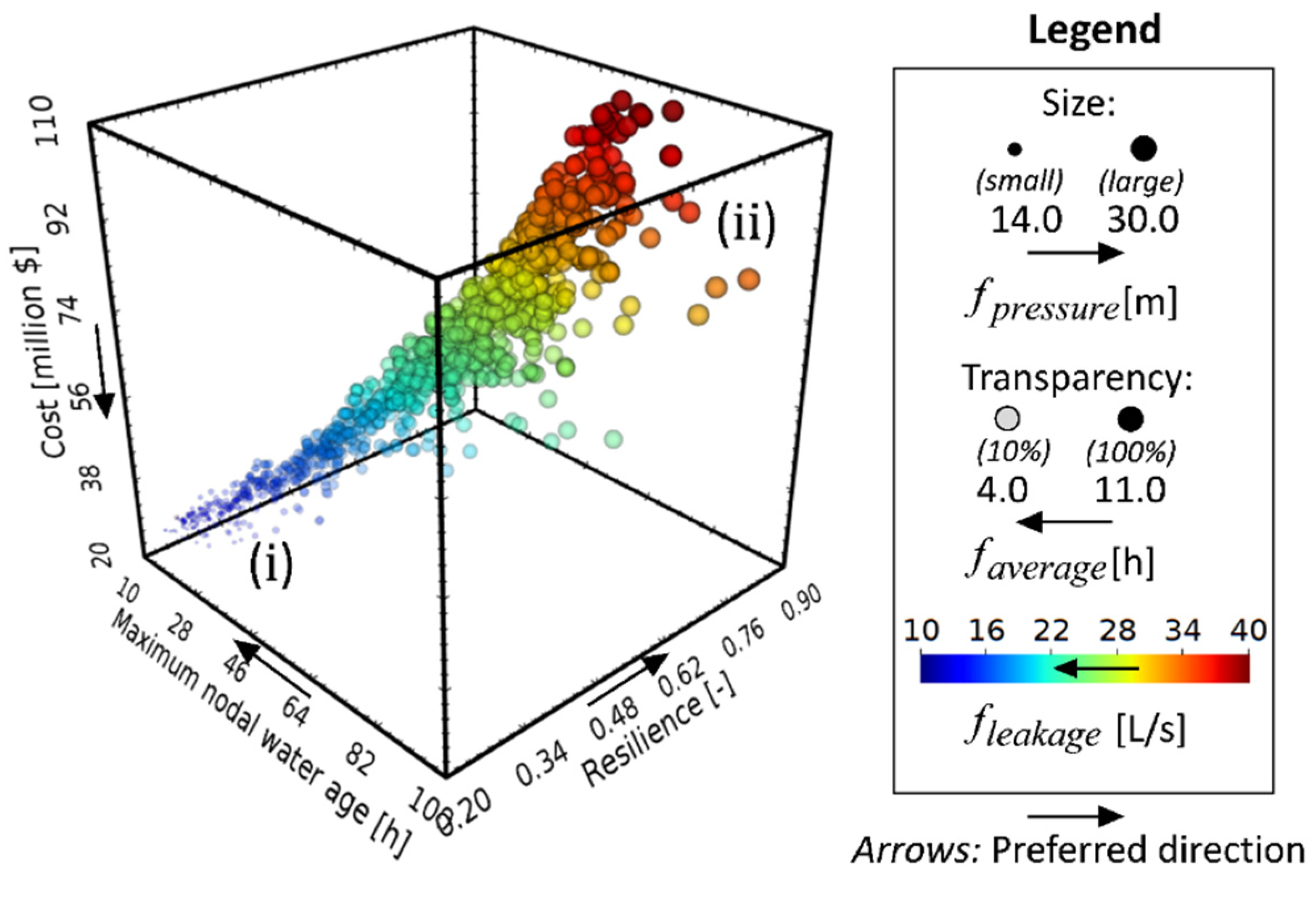
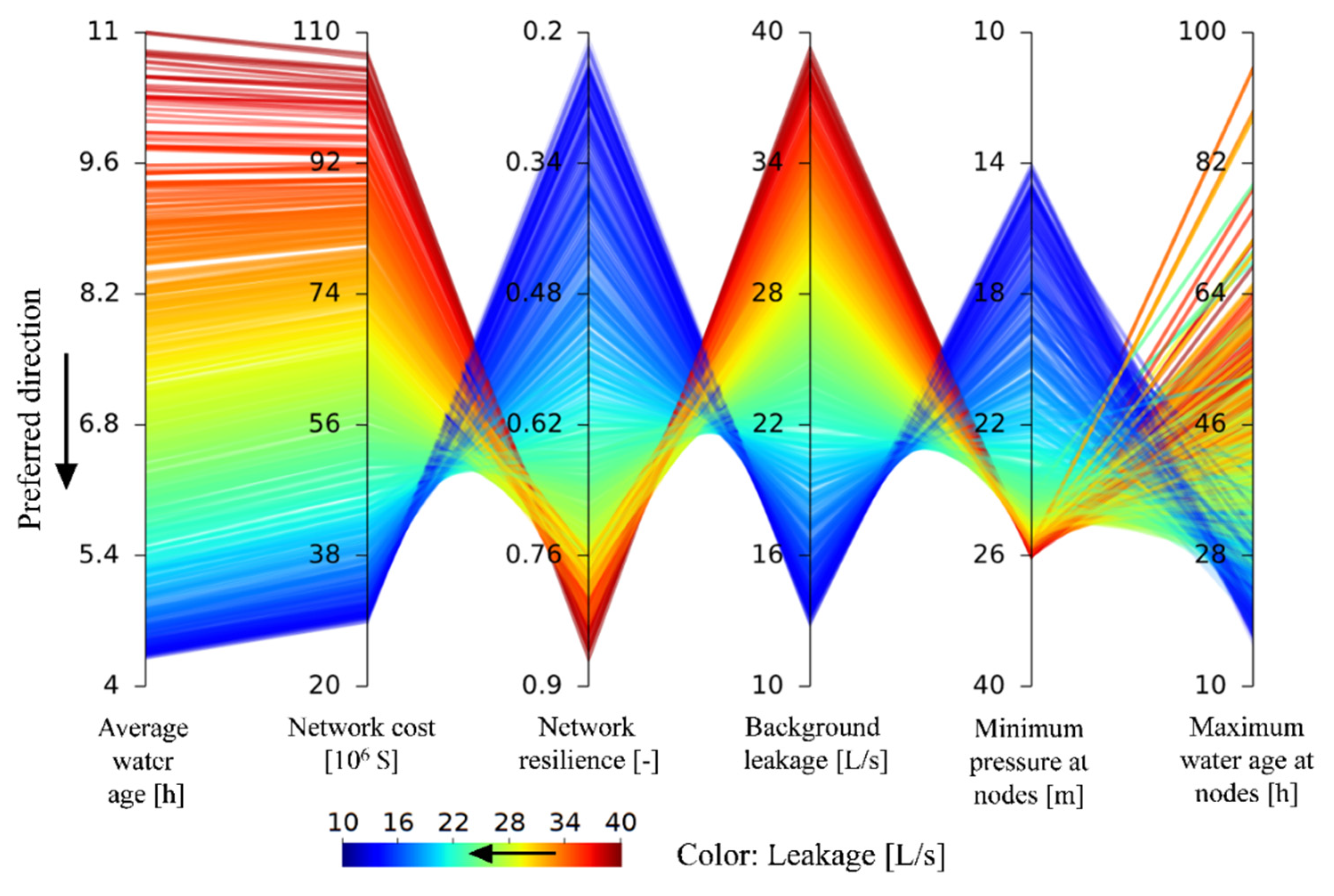
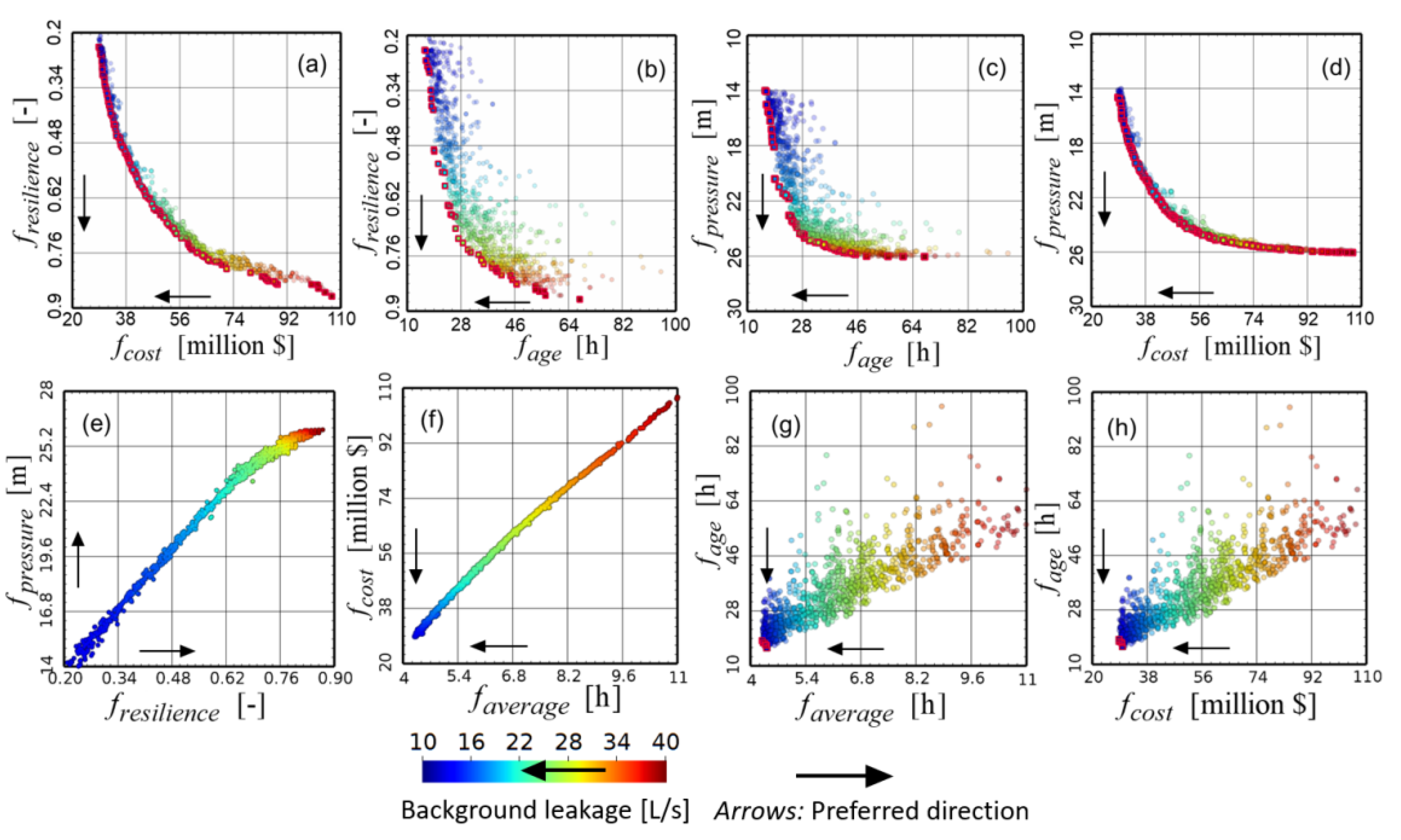
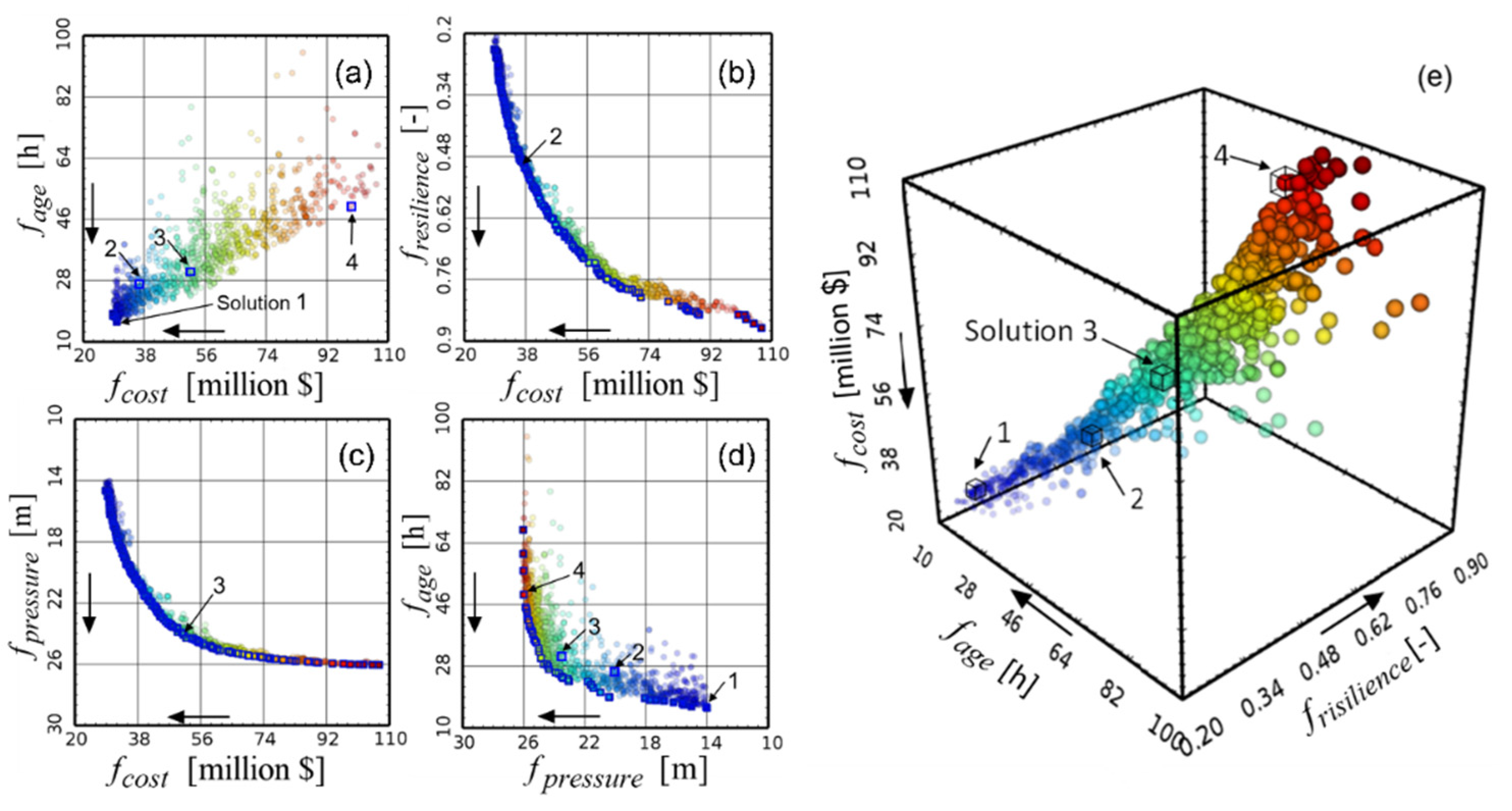

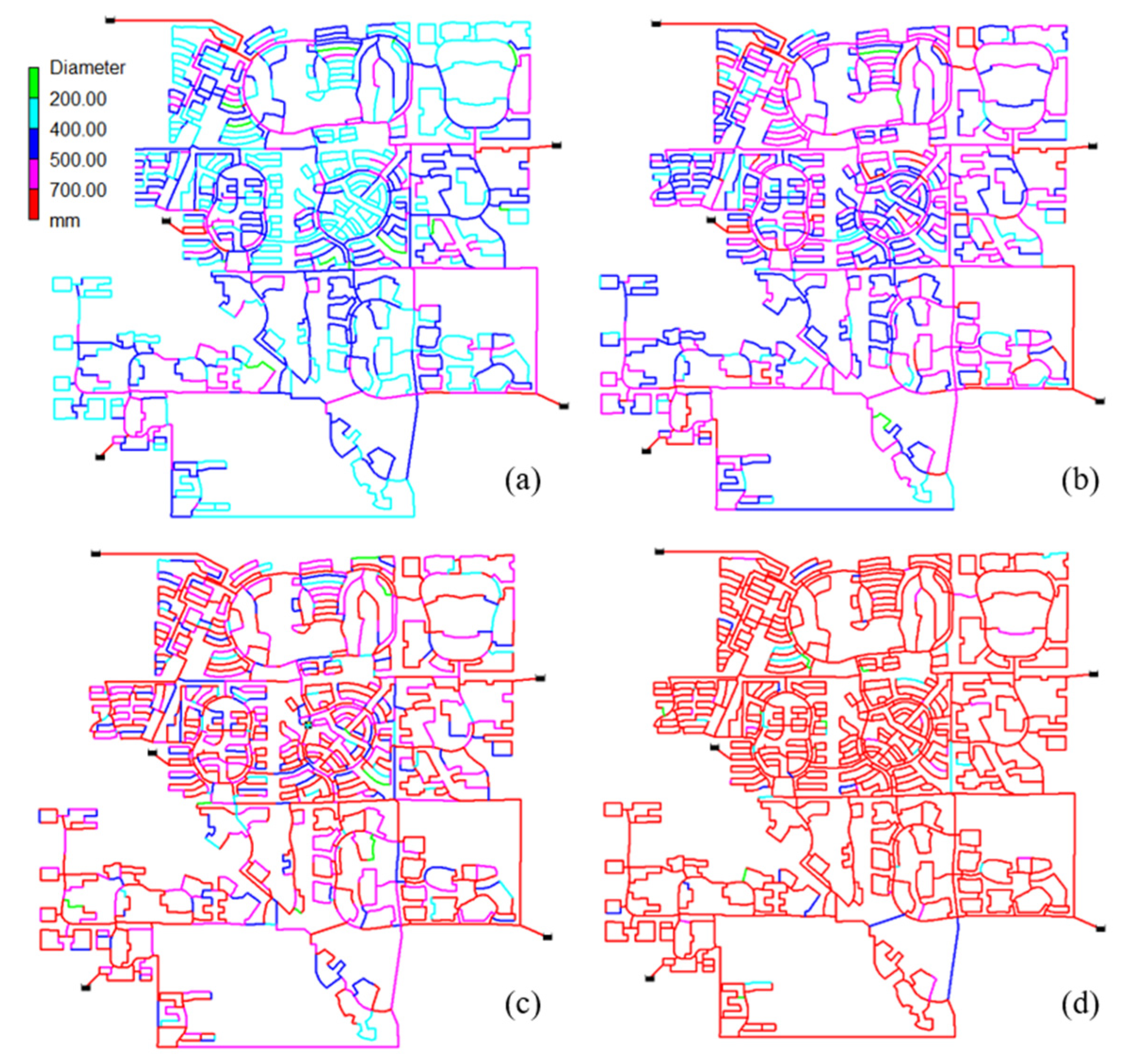


Publisher’s Note: MDPI stays neutral with regard to jurisdictional claims in published maps and institutional affiliations. |
© 2022 by the authors. Licensee MDPI, Basel, Switzerland. This article is an open access article distributed under the terms and conditions of the Creative Commons Attribution (CC BY) license (https://creativecommons.org/licenses/by/4.0/).
Share and Cite
Bi, W.; Chen, M.; Shen, S.; Huang, Z.; Chen, J. A Many-Objective Analysis Framework for Large Real-World Water Distribution System Design Problems. Water 2022, 14, 557. https://doi.org/10.3390/w14040557
Bi W, Chen M, Shen S, Huang Z, Chen J. A Many-Objective Analysis Framework for Large Real-World Water Distribution System Design Problems. Water. 2022; 14(4):557. https://doi.org/10.3390/w14040557
Chicago/Turabian StyleBi, Weiwei, Minjie Chen, Shuwen Shen, Zhiyuan Huang, and Jie Chen. 2022. "A Many-Objective Analysis Framework for Large Real-World Water Distribution System Design Problems" Water 14, no. 4: 557. https://doi.org/10.3390/w14040557
APA StyleBi, W., Chen, M., Shen, S., Huang, Z., & Chen, J. (2022). A Many-Objective Analysis Framework for Large Real-World Water Distribution System Design Problems. Water, 14(4), 557. https://doi.org/10.3390/w14040557




